 (Left: Fiber-to-the-home converter box at my mother-in-law's rural Wisconsin home. The optical signal is converted into an electrical signal at the box and then routed into the house. The black cable is the input optical fiber bundle; if you squint, you can make out some additional yellow-jacket, fiber patch-cords through an opening at the base of the box.)
(Left: Fiber-to-the-home converter box at my mother-in-law's rural Wisconsin home. The optical signal is converted into an electrical signal at the box and then routed into the house. The black cable is the input optical fiber bundle; if you squint, you can make out some additional yellow-jacket, fiber patch-cords through an opening at the base of the box.)Like usual, this Christmas holiday my family and I spent some time at my mother-in-law's rural home in Spring Valley, Wisconsin enjoying good food, fresh air, and the escape from the confines and bustle of city-living. However, what was different about this year's visit was her home's new Terabit/s capacity for current and future digital communication and entertainment needs. My mother-in-law lives in one of six million American homes that currently have Fiber-to-the-home (FTTH) connectivity.
Her service provider, West Wisconsin Telecom Cooperative, is part of a growing number of American rural telecoms and municipalities surpassing their urban counterparts in the future of lightwave communications. Much of this rural technological growth has been made possible through grants and low-interest loans from the United States Department of Agriculture (USDA) Rural Utility Service (RUS) Telecommunications Program whose aim is to improve education, health, and economic opportunities of rural families and businesses through broadband internet access.

(Above: The neighbor's farm across the street .)
Seeing and using FTTH in person at my mother-in-law's got me excited about its implications on photonics research and applications, and science in general. Though CLEO is not a telecom- centered conference like OFC (optical fiber communications conference), there is much that fundamental science and optics research can leverage from telecom technology and visa-versa. The growth in one field breeds growth in the other. For a nice paper about the symbiotic relationship between great physics discoveries and advances in telecommunications technology, see Brinkman and Lang's 1999 Reviews of Modern Physics paper "Physics and the Communications Industry."
Though I may be biased towards fiber-based technologies, to me the links between work presented at CLEO and the growth of telecom is pervasive. For starters, the first CLEO plenary speaker, Donald Keck, will share stories of how his team at Corning pioneered the first usable low-loss fiber in 1970 and discuss its place in the broader context of the ensuing optical technology and information revolution. The exciting history of bringing down the loss of optical fiber (which in its infancy was an opaque 1000 dB/km) involves a Nobel prize (Charles Kao correclty hypothesized the bottleneck to transparency) and the development of the groundbreaking fabrication technique of modified chemical vapor deposition (MCVD) by John MacChesney's team at Bell Labs, which brought loss down to what it is today.
As Keck will likely discuss, making fiber transparent paved the way not only for a host of other telecom and information technologies but new fields of photonics. For communications, once you have an acceptable waveguide, you still need sources, modulators, detectors, amplifiers, routers, multiplexers, switches. For the most recent breakthoughs in telecom be sure to attend CLEO: Science and Innovation 12: Lightwave Communication and Optical Networking.
Naturally, the field of quantum communications is tied up in current telecom technology. CLEO Symposium on Quantum Communications will host papers in both fundamental science research in quantum information and actual quantum communication testbeds- fiber-based and free-space.
You can find telecom-derived technology in CLEO: Science and Innovation 11: Fiber Amplifiers Lasers and Devices. This session includes topics such as CW and pulsed mode-locked fiber oscillators, amplification in doped fibers, ultra-wideband fiber amplifiers, Raman amplifiers, coherent and incoherent combination of fiber lasers and amplifiers, fiber-based nonlinear effects, fiber-grating and microstructured fiber devices. The applications for these technologies range from spectroscopy, biomedical imaging, and materials processing.

(Above: Sign marking the location of buried fiber)
My excitement at my mother-in-law's FTTH led to some disappointment about the speed of her computer (any computer for that matter). She has ~100 Tb/s capacity, but only ~Gb/s capability. To get the capability you need to move to all-optical signal processing and optical computing. CLEO will host a variety of sessions regarding or related to this important technological goal. See CLEO-QELS Fundamental Science 6: Nano-optics and plasmonics; CLEO: Science and Innovation 7: Nano-optics Micro- and Nano-photonic devices; and CLEO: Science and Innovation 9: Components, Integration, Interconnects and Signal Processing. Among other ground-breaking research, I anticipate contributed papers from the Cornell Nanophotonic's Group whose P.I., Michal Lipson, recently received a MacArthur Genius Award , ($500k no strings attached) for her pioneering work in silicon-based circuits for practical optical computing.
The list of sessions at CLEO inspired by optical fiber and telecom technology goes on. One of my hopes for 2011 is to witness FTTH to more of the country, rural and urban. This isn't just job security for us all, but may prove pivotal to the growth and expansion of innovation in optics and science.

No comments:
Post a Comment